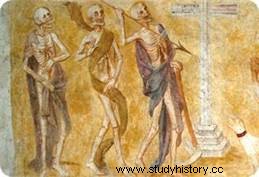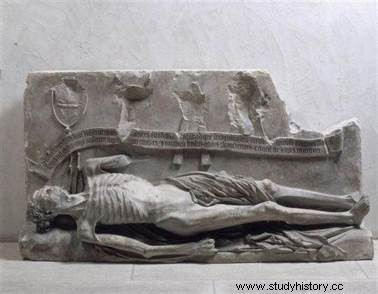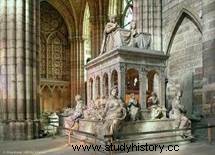 At the end of the Middle Ages, the princes mobilize the patronage system for their final resting place, built during their lifetime. The society of the time was marked by the phenomenon of death, as shown for example by the dances of death. Thus develops an ars moriendi , sets of instructions aimed at preparing the Christian for death. Illustrated guides are published where the fight between the forces of evil and those of good is shown, having as a theater the bed of the dying. To die well, you have to avoid certain pitfalls, such as pride or greed. However, the princes organize their death in a sumptuous way. Is the funerary art that developed at the end of the Middle Ages then the manifestation of a particular piety, or an artistic manifestation contingent on dynastic necessities?
At the end of the Middle Ages, the princes mobilize the patronage system for their final resting place, built during their lifetime. The society of the time was marked by the phenomenon of death, as shown for example by the dances of death. Thus develops an ars moriendi , sets of instructions aimed at preparing the Christian for death. Illustrated guides are published where the fight between the forces of evil and those of good is shown, having as a theater the bed of the dying. To die well, you have to avoid certain pitfalls, such as pride or greed. However, the princes organize their death in a sumptuous way. Is the funerary art that developed at the end of the Middle Ages then the manifestation of a particular piety, or an artistic manifestation contingent on dynastic necessities?
The funerary statuary of princes at the end of the Middle Ages
The royal tombs are all located in the Basilica of Saint-Denis, with the exception of Louis XI. Recumbent figures appear on tombs in the 12th century. They are first placed in the transept (sixteen recumbent figures), then to the north in the 14th century for the sons of Philippe Le Bel, and to the south for Charles V and Charles VI; finally, from the 16th century, the tombs were scattered around the basilica due to their increasingly monumental size (Louis XII in the north, François I in the south, for example). The recumbent statue serves as a testimony to his faith, and the princes are often idealized there, with symbols of their piety such as the dog (fidelity), the lion (strength) and the orientation towards Jerusalem as can be seen with the tomb of Charles IV and Joan of Evreux (after 1328).
Realistic features appear on the faces of recumbent figures at the end of the 13th century, with Philip III and his wife Isabella of Aragon; the latter appears with a face marked by pain (she died after falling from a horse). This realism is largely due to the wax casting that is made of the faces of the deceased. This subsequently inspired the recumbent statues, particularly in the 15th century. The Duke of Burgundy Philippe le Hardi (died in 1404) created a fashion that went so far as to influence the King of France and the other great princes of the kingdom, such as the Duke of Berry. This is particularly the case of the lower register of the tomb at the Charterhouse of Champmol, with an arcade within which there are couples of statuettes in the round, dressed in homespun robes, a real funeral procession and, among this procession, ecclesiastics, nobles, members of the ducal house; they cry, they are mourners, each face expressing feelings. The Dukes of Burgundy developed this funerary art up to Charles the Bold, with patronage that supported artists such as Jean de Marville, Claude Suter or the painter Jean Malouel.
Before the 15th century, the body of the king was embalmed, surrounded by regalia and we separate the heart and the entrails. On the death of Charles VI (1422) the effigy was invented, which lasted until Henry IV (died 1610):with a leather mask and a wooden body, the fiction of the body was maintained by serving it meals and by walking the effigy during the funeral. This symbolism is linked to the idea of the two bodies of the king, one physical and mortal, the other representing the immortal monarchy. Once the effigy is presented, the officers shout:"the king is dead, long live the king", and the new sovereign can appear. 
Celebrate a dynasty and heroize the prince
The princes of the late Middle Ages wanted to pay homage to their ancestors and their families. Thus, in Saint-Denis, there are just as many kings as queens and their children. It is the dynasty, and not just the monarchy, that is honored.
One of the most famous examples is the tomb of Louis XII and Anne of Brittany, by Guido Mazzoni, an Italian artist who worked for the Duke of Ferrara. The triumphal arch, in antique style, is a novelty in France, imported from an Italy in the midst of the Renaissance. However, the tomb is despite everything very French because it grants prayer and macabre concern. The tomb reads like a journey:we insist on the corruptibility of the body, but at the same time we have confidence in the future and in the resurrection for virtuous sovereigns. The tomb of Francis I and Claude of France is even more the sign of a mixture between the French style and the Italian style, with a heroization of the prince.
If we compare France and Italy, the heroization of the prince in the tombs is more complex than it seems. That of the Grand Seneschal of Normandy, Louis de Brézé (1460-1531), presents the deceased on horseback and triumphant militarily, surrounded by caryatids. For Francis I, on the other hand, we are more in the representation of the Christian king triumphant over death. In Italy, the Medici Chapel, intended first for Lorenzo and Pierre de Médicis, was designed by Michelangelo, but did not insist on heroization, rather on the brevity of life and melancholy, despite a set more monumental than in Saint-Denis. As for the tomb of Pope Julius II, again by Michelangelo, it is so ambitious and expensive that it is not completed, but it was supposed to show a warlike and heroic pope in the face of external enemies, all in the presence of Moses. .

Other princes want to honor their dynasty, and for that they sometimes take inspiration from the royal model. This is the case, for example, of Anne de Montmorency (1492-1567) and her mausoleum. Grand feudal prince and great patron, he knows Italy well, but yet his tomb goes back to the chivalrous ideals of the Middle Ages, drawing inspiration only in part from the monumentality of the kings of France. The mausoleum was however made by Renaissance artists, such as Barthélemy Prieur. The prince is represented lying, his hands clasped in prayer, with his constable's sword at his side. He also reconnects with his ancestors:in a sanctuary, in Montmorency, there is a collegiate church visually arranged by orders representing the family (stained glass windows with the father, the son, etc.). The taste of a great feudal may therefore differ on certain points from that of his sovereign.
Bibliography
- E. Kantorowicz, The King's Two Bodies , Gallimard, 1989 (1 era edition, 1957).
- R. E. Giesey, The King Never Dies , Flammarion, 1987.
- E. Male, Religious Art of the Late Middle Ages in France , A. Colin, 1995 (1 era edition, 1908).
- B. Bové, Time of the Hundred Years War (1328-1453) , Belin, 2009.
- P. Hamon, The Renaissances (1453-1559) , Belin, 2009.
- N. Le Roux, The Wars of Religion (1559-1629) , Belin, 2009.
Article inspired by a course given by Mr. Amalou, Paris 1, as part of the CAPES preparation.
